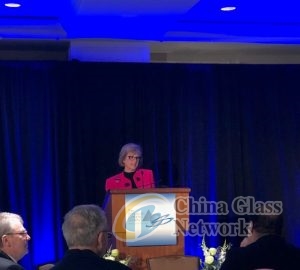Post Time:Apr 07,2022Classify:Industry NewsView:1283
Wednesday marks the official kick-off of the International Year of Glass (IYOG) in the U.S. The National Day of Glass, organized by the American Ceramic Society, takes place this week at The Madison in Washington, D.C. The program includes a variety of talks and panel discussions from industry leaders representing large and small companies. Other participants include those from government, academia, art, and more, recognizing all the contributions of glass.

Kathleen Richardson, National Day of Glass convening chair, welcomed attendees to the U.S. kickoff the International Year of Glass.
Kathleen Richardson, who serves as National Day of Glass convening chair, said while the event will provide a historical perspective of glass, it’s also in line with the United Nations’ 2023 goals to highlight the future direction glass is expected to take us.
Glass is Amazing
The day began with a dynamic presentation from Wendell Weeks, chairman and CEO of Corning Inc., who talked about why glass is vital to the future. Weeks shared how he loves how glass forms, feels, transforms, takes on color, and “how alive glass feels.”
He also discussed how scientists and engineers use glass to solve some of the toughest challenges and said the more it evolves, “the more glass has made its way into all of our lives.”
Weeks addressed four important attributes of glass: stability, strength, interaction with light, and impermeability.
Wendell Weeks, chairman and CEO of Corning Inc., discussed why glass is vital to the future.
Speaking of its stability, he pointed out that glass can endure for millennia. It’s stable at the macro level but can change at the micro level. On its strength, he said historically glass is thought of as fragile, but “glass is incredibly strong.” As an example, he pointed to Corning’s Gorilla Glass, which was originally made for the iPhone.
Weeks also talked about the interaction of glass with light and manipulating the relationship between the two. Huge strides have occurred in this area, such as in optical fibers for telecommunications.
Regarding natural impermeability, Weeks said glass has been used for thousands of years as a container because of its effectiveness in protecting contents. That was critical most recently in the development of the COVID-19 vaccine, thanks to advanced pharmaceutical packaging. For centuries, he said, borosilicate glass vials were used. But borosilicate brings challenges such as being prone to breakage, susceptible to heat and cold, and can even hamper efficiencies for drugmakers. Corning developed a new glass, approved by the FDA, to meet these demands and when the pandemic hit was able to work with drug makers to deliver vaccines.
“Glass is amazing,” he said. “What will happen as we keep unlocking mysteries … think of the possibilities …The biggest contributions lie ahead.”
Age of Glass
Stone Age, Bronze Age, Iron Age; what about the Glass Age? That’s what Stephen Eskilson, a professor at Eastern Illinois University, would like to see. An “age,” he said, is when a material defines an era in not only a technical and functional sense but also symbolical and metaphorical. Glass, he explained, has transitioned from an industrial to a digital era. “Not all materials can jump like that,” he said.
According to Eskilson, one of the key factors driving the Glass Age is visibility. “Glass has two front-facing practices: the skins of buildings and screens. Hard to compete with that visibility.
He talked about the evolution of glass on the façade as well as digital technologies used every day, such as iPhones and tablets. It’s hard to compete with this type of display, he said.
Source: usgnn.comAuthor: shangyi